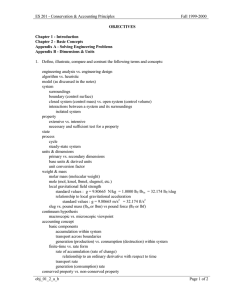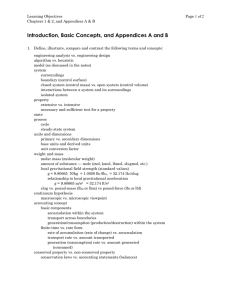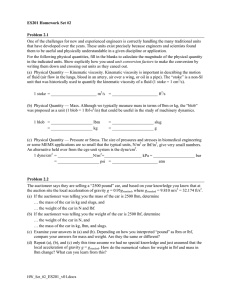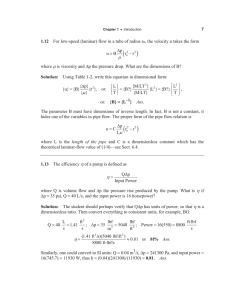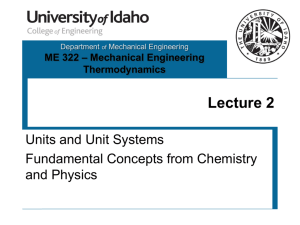MAE 113 HW2 Solution.nb
advertisement
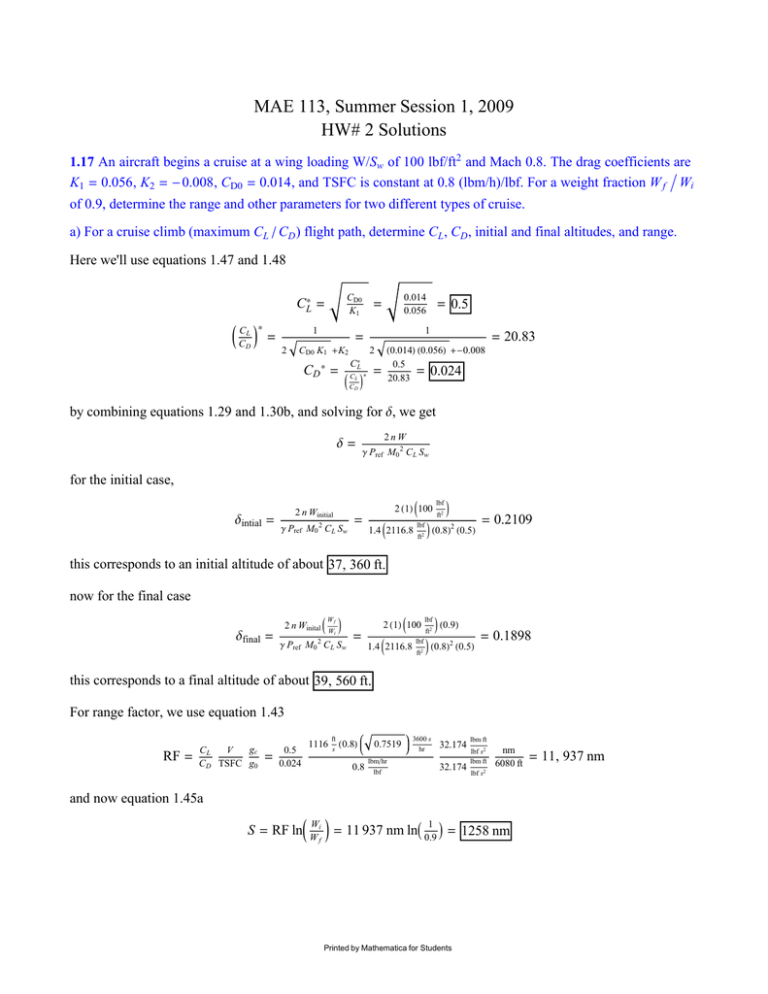
MAE 113, Summer Session 1, 2009 HW# 2 Solutions 1.17 An aircraft begins a cruise at a wing loading W/Sw of 100 lbf/ft2 and Mach 0.8. The drag coefficients are K1 = 0.056, K2 = -0.008, CD0 = 0.014, and TSFC is constant at 0.8 (lbm/h)/lbf. For a weight fraction W f ë Wi of 0.9, determine the range and other parameters for two different types of cruise. a) For a cruise climb (maximum CL ê CD ) flight path, determine CL , CD , initial and final altitudes, and range. Here we'll use equations 1.47 and 1.48 CD0 K1 CL* = * J CL N = C D 1 2 0.014 0.056 = 1 = CD0 K1 +K2 H0.014L H0.056L +-0.008 0.5 = 0.024 20.83 2 C*L CL * CD * = = 0.5 = JC N = 20.83 D by combining equations 1.29 and 1.30b, and solving for d, we get d= 2nW g Pref M0 2 C L Sw for the initial case, dintial = 2 n Winitial 2 g Pref M0 C L Sw = 2 H1L J100 1.4 J2116.8 lbf ft2 lbf ft2 N N H0.8L2 H0.5L = 0.2109 this corresponds to an initial altitude of about 37, 360 ft. now for the final case 2 n Winital J W N 2 H1L J100 Wf dfinal = i 2 g Pref M0 C L Sw = 1.4 J2116.8 lbf lbf ft2 ft2 N H0.9L N H0.8L2 H0.5L = 0.1898 this corresponds to a final altitude of about 39, 560 ft. For range factor, we use equation 1.43 RF = gc CL V C D TSFC g0 = 0.5 0.024 1116 ft s H0.8L 0.8 0.7519 3600 s hr lbmêhr 32.174 32.174 lbf lbm ft lbf s2 lbm ft nm 6080 ft lbf s2 and now equation 1.45a S = RF lnJ W i N = 11 937 nm lnI 0.9 M = 1258 nm W 1 f Printed by Mathematica for Students = 11, 937 nm 2 MAE 113 HW2 Solution.nb CL ë CD ) flight path, determine CL , CD , initial and final altitudes, and range. b) For a level cruise (maximum We start back at equation 1.32 CD = K1 CL 2 + K2 CL + CD0 = K1 CL 3ê2 + K2 CL 1ê2 + CD0 CL -1ê2 CD CL ∑ ∑C L CD CL ∑ ∑C L CD 3 2 = CL 0= 3 2 IK1 CL 3ê2 + K2 CL 1ê2 + CD0 CL -1ê2 M ∑ ∑C L = 1 2 K1 CL 1ê2 + 0= 3 2 K1 C L 2 + K2 CL -1ê2 + K2 CL -1ê2 + 1 2 K2 C L 1 + 2 1 K 2 2 3 2 J 2 K1 N ≤ CL = 2 K2 +12 K1 CD0 -K2 6 K1 CL = CD0 CL -3ê2 3 -1 2 CD0 N 2 J 2 K1 N 3 1 K2 6 K1 -1 2 -1 CD0 CL -3ê2 2 -1 CD0 CL 0 2 J 2 K2 N -4 J 2 K1 N J 1 CL = - 1 2 K1 CL 1ê2 + 4 + K2 2 +3 K1 CD0 3 K1 H-0.008L +12 H0.056L H0.014L -- 0.008 6 H0.056L 2 = = 0.3135 CD = H0.056L H0.3135L2 + H-0.008L H0.3135L + 0.014= 0.0170 now solving for d as before d= 2 n Winitial 2 g Pref M0 C L Sw = 2 H1L J100 1.4 J2116.8 lbf ft2 lbf ft2 N N H0.8L H0.3135L 2 = 0.3365 this corresponds to a final altitude of about 27, 280 ft. For initial velocity, V = M astd q = 0.8 I1116 s M ft 0.8141 = 805.6 ft ê s And final velocity is given by V = Vi Wf = 805.6 Wi ft s 0.9 = 764.2 ft ê s Now, range factor RF = gc CL V C D TSFC g0 = 0.3135 0.0170 1116 ft s H0.8L 0.8 0.8141 lbmêhr lbf 3600 s hr 32.174 32.174 Printed by Mathematica for Students lbm ft lbf s2 lbm ft lbf s2 nm 6080 ft = 10, 994 nm MAE 113 HW2 Solution.nb And range comes from problem 1-16 since the altitude is too low for the Breguet range equation to apply Wf Wi s = 2 RFi 1 - Wf Wi = J1 - 2 s N 2 RFi = 2 H10 994 nmL I1 - s = 1128.4 nm Printed by Mathematica for Students 0.9 M 3 4 MAE 113 HW2 Solution.nb 1.21 Rocket motor on static stand with exhaust of 100 lbm/s and exit velocity 2000 ft/s and pressure 50 psia. Exit area is 0.2 ft2 . For ambient pressure of 14.7 psia, determine effective exhaust velocity, thrust transmitted to test stand, and the specific impulse. Effective exhaust velocity is defined in equation 1.53 HPe -Pa L Ae gc ° mp C ª Ve + C = 2000 ft s + J50 lbf in2 -14.7 lbf in2 N I0.2 ft2 M 32.174 144 in2 ft2 lbm 100 C = 2327.1 s ft s Now static thrust is defined by equation 1.54 F= F= 100 ° mp C gc lbm s 2327.1 32.174 ft s lbm ft 2 lbf s F = 7232.8 lbf And Isp is given by equation 1.56 Isp = Isp = C g0 2327.1 32.174 ft s ft s2 Isp = 72.3 s Printed by Mathematica for Students lbm ft lbf s2 MAE 113 HW2 Solution.nb 5 1.22 Rocket motor static testing with exhaust 50 kg/s at 800 m/s and 350 kPa. Exit area is 0.02 m2 . For ambient pressure 100 kPa, determine the effective exhaust velocity, thrust, and specific impulse. We'll follow the same plan as 1.21 C ª Ve + C = 800 m s + HPe -Pa L Ae gc ° mp H350 000 Pa-100 000 PaL I0.02 m2 M C = 900 50 m s kg s Now static thrust is defined by equation 1.54 F= F= 50 ° mp C gc kg s 900 m s 1 F = 45 000 And Isp is given by equation 1.56 C g0 m 900 s Isp = Isp = 9.8 m s2 Isp = 91.84 s Printed by Mathematica for Students 6 MAE 113 HW2 Solution.nb 2.12 Air at 1400K, 8 atm, and 0.3 Mach expands isotropically through a nozzle to 1 atm. Assuming a calorically perfect gas, find the exit temperature and the inlet and exit areas for a mass flow rate of 100 kg/s. Let's start with equation 2.43 T2 = P Hg-1Lêg T1 I P2 M 1 T2 T1 Hg-1Lêg = I P2 M P 1 1 atm H1.4-1Lê1.4 = 1400 KI 8 atm M = 772.9 K Now let's use equation 2.12b for the mass flow rate ° m1 = r A 1 V A1 = ° m1 rV And equation 2.21 brings in pressure P = rRT Also, equation 2.36 helps us get V g R gc T V =aM = M plugging these in for area, ° m1 R T1 A1 = P1 M1 ° m1 P1 M1 = g R gc T 1 R T1 g gc = 287 100 kgês 8 atm 101 300 Pa atm H0.3L J kg K 1.4 K1 A1 = 0.2204 m2 Now use the equation in the middle of page 86, from the first law of thermodynamics c p T1 + V12 2 gc = c p T2 + V22 2 gc First, we apply equation 2.36 M12 g R gc T1 M22 g R gc T2 = c T + p 2 2 gc 2 gc M12 g R M22 g R T1 Jc p + 2 N = T2 Jc p + 2 N M2 g R M2 g R T1 J1 + 21 c N = T2 J1 + 22 c N p p c p T1 + Printed by Mathematica for Students 1400 K m3 kg s2 O MAE 113 HW2 Solution.nb Next we apply equation 2.30 T1 J1 + T1 J1 + g-1 N g M12 g 2 = T2 J1 + Hg - 1LN = T2 J1 + M12 2 M22 g g-1 N 2 g 2 M2 Hg - 1LN 2 Solving for M2 M2 = 2 T1 J1+ M12 2 Hg-1LN-T2 T2 Hg-1L = 2 1400 KJ1+ H0.3L2 2 H1.4-1LN-772.9 772.9 H1.4-1L and, as before A2 = ° m2 P2 M2 R T2 g gc = 100 kgês 1 atm 101 300 Pa atm H2.054L A2 = 0.1913 m2 Printed by Mathematica for Students 287 J kg K 772.9 K 1.4 H1L = 2.054 7 8 MAE 113 HW2 Solution.nb 2.17 Air at 225K, 28 kPa, and M=2.0 enters an isentropic diffuser with an inlet area of 0.2m2 and leaves at M=0.2. Assuming a calorically perfect gas, determine: a) The velocity and mass flow rate of the entering air We remember equation 2.36 V1 = a M1 = M1 H1.4L J287 g R gc T1 = 2.0 J N H1L H225 kg K KL V1 = 601.3485 m ê s With the assistance of 2.12b and 2.21, we get ° m1 = P A1 V RT 28 000 Pa I0.2 m2 M H601.3485 mêsL = 287 J kg K 225 K ° m1 = 52.15 kg ê s b) The pressure and temperature of the leaving air From problem 2.12, using Mach number and the first law of thermodynamics, we derived T1 J1 + T2 = M12 2 T1 J1+ J1+ Hg - 1LN = T2 J1 + M12 2 M22 2 Hg-1LN Hg-1LN Hg - 1LN M22 2 H2.0L H1.4-1LN 2 225 KJ1+ = J1+ H0.2L2 2 2 H1.4-1LN T2 = 401.79 K and now 2.43 lets us find pressure T2 T1 g P2 = T P1 I T2 M g-1 1 Hg-1Lêg = I P2 M P 1 1.4 = 28 000 PaI 401.79 K 1.4-1 M 225 K P2 = 213.067 kPa c) The exit area and magnitude and direction of the force on the diffuser (assume outside of diffuser is 28 kPa) First we want exit area. Using the equation derived in problem 2.12 A2 = ° m2 P2 M2 R T2 g gc = 52.15 kgês 213 067 PaH0.2L 287 J kg K 401.79 K 1.4 H1L A2 = 0.3512 m2 Now we can find V2 V2 = a M2 = M2 g R gc T2 = 0.2 H1.4L J287 V2 = 80.3590 m ê s Printed by Mathematica for Students J N H1L H401.79 kg K KL MAE 113 HW2 Solution.nb If the force F points from 1 to 2, then SF x = -HP2 - Pa L A2 + HP1 - Pa L A1 + F SFx = ° m gc HV2 - V1 L so F= F= 52.15 1 kg s I80.3590 m s - 601.3485 ° m gc HV2 - V1 L + HP2 - Pa L A2 - HP1 - Pa L A1 m M + H213 067 s Pa - 28 000 PaL 0.3512 m2 - H28 000 Pa - 28 000 PaL 0.2 m2 F = 37, 826 Printed by Mathematica for Students 9 10 MAE 113 HW2 Solution.nb 2.21 50 kg/s of air enters compressor at 1 atm and 20°C and leaves at 20 atm and 427°C. If the process is adiabatic, find the input power, specific volume at exit, and change in entropy. Is the process reversible. (Assume a calorically perfect gas.) We can start with equation 2.13 ° ° ° Q - Wx = mJh + V2 2 gc + gz ° V2 N - mJh + 2 g gc out c + gz N gc in As shown on the middle of page 70, in this case ° mJh + V2 2 gc ° gz V2 N m Jh + gc out 2 gc + + gz N gc in =0 and so ° ° ° ° kg Wx = Q = m q = m c p HT2 - T1 L = 50 s J1003.5 ° Wx = 20.42 MW J N H700 kg K K - 293 KL the perfect gas equation PV=nRT gives specific volume as V2 = RT2 P2 = J287 J kg K 20 atm N H700 KL 101 300 Pa atm m3 kg V2 = 0.0988 To find change in entropy, we use equation 2.40 s2 - s1 = Ds = c p lnI T2 M - R lnI P2 M = 1003.5 T P 1 1 Ds = 14.18 J kg K J kg K lnI 293 K M - 287 700 K J kg K lnI 20 atm M 1 atm Since the entropy increases for an adiabatic process, the second law of thermodynamics tells us that this process is not reversible. Printed by Mathematica for Students MAE 113 HW2 Solution.nb 11 2.22 Given 200 lb/s of air enters a steady flow turbine at 20 atm and 3400°R. It leaves at 10 atm. For a turbine efficiency of 85%, determine the exit temperature, output power, and change in entropy. (Assume a calorically perfect gas.) To find the exit temperature, let's use the definition of turbine efficiency. A modified version of equation 6.18 gives us ht = h1 -h2 h1 -h2 s = T1 -T2 T1 -T2 s T2 = T1 - ht HT1 - T2 s L We also use T2 s = T1 I P2 M P 1 g-1 g = 3400 °RI 20 atm M 10 atm 1.4-1 1.4 = 2789.14 °R T2 = 3400 °R - 0.85 H3400 °R - 2789.14 °RL T2 = 2880.77 °R Now we use the equation from above, but switch T1 and T2 since we are using a compressor instead of a turbine. ° ° ° ° lb Btu Wx = Q = m q = m c p HT1 - T2 L = 200 s I0.24 lb °R M H3400 °R - 2880.77 °RL ° Btu Wx = 24, 926 s ° Btu 1055 W Wx = 24, 926 s Btuês ° Wx = 26.298 MW And, we can also find Ds as before Ds = c p lnI T2 M - R lnI P2 M = 0.24 T P 1 1 2880.77 °R ft lbf Btu M - 53.35 lbm °R 778.16 lbf 3400 °R Btu 0.0077 lbm °R Btu lbm °R Ds = lnI Printed by Mathematica for Students lnI 20 atm M 10 atm
